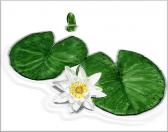White Water-lily - Nymphaea alba
This beautiful water plant, known locally at Fucecchio as Fogliaccine, has a strong, fleshy rhizome buried in the mud. Several leaf stalks grow from the rhizome, varying in length depending on the depth of the water, but usually no longer than 3 m.
These carry aeriferous canals which supply the roots buried in the mud with oxygen. The rounded leaves, up to 30 cm long, gradually uncurl as they grow and only open completely when they reach the water surface.
The large floating flowers (up to12 cm in diameter) have 4 green outer sepals and numerous white petals which change into golden stamens as they approach the centre.
Thanks to their air-containing walls, the seeds are carried by the wind and weak currents, so assuring their dissemination. The plant's survival is also guaranteed by its rhizome which can survive the winter thanks to its starch reserves.
It flowers from April to September. It lives in still or slow-flowing waters, not too rich in nutrients. It is widespread mostly in the Po Valley, but it also occurs in many of peninsular regions and the larger islands.
However it is becoming more and more rare everywhere because of negative factors, differing from place to place.
Following the widespread proliferation of the Nutria and Red Swamp Crayfish, this species, which had already disappeared from the Ramone Marshlet, has drastically fallen in numbers, to the extent that in the last few years it has not been seen either in the Fucecchio Marshes canals nor in the waters of Lake Sibolla.




